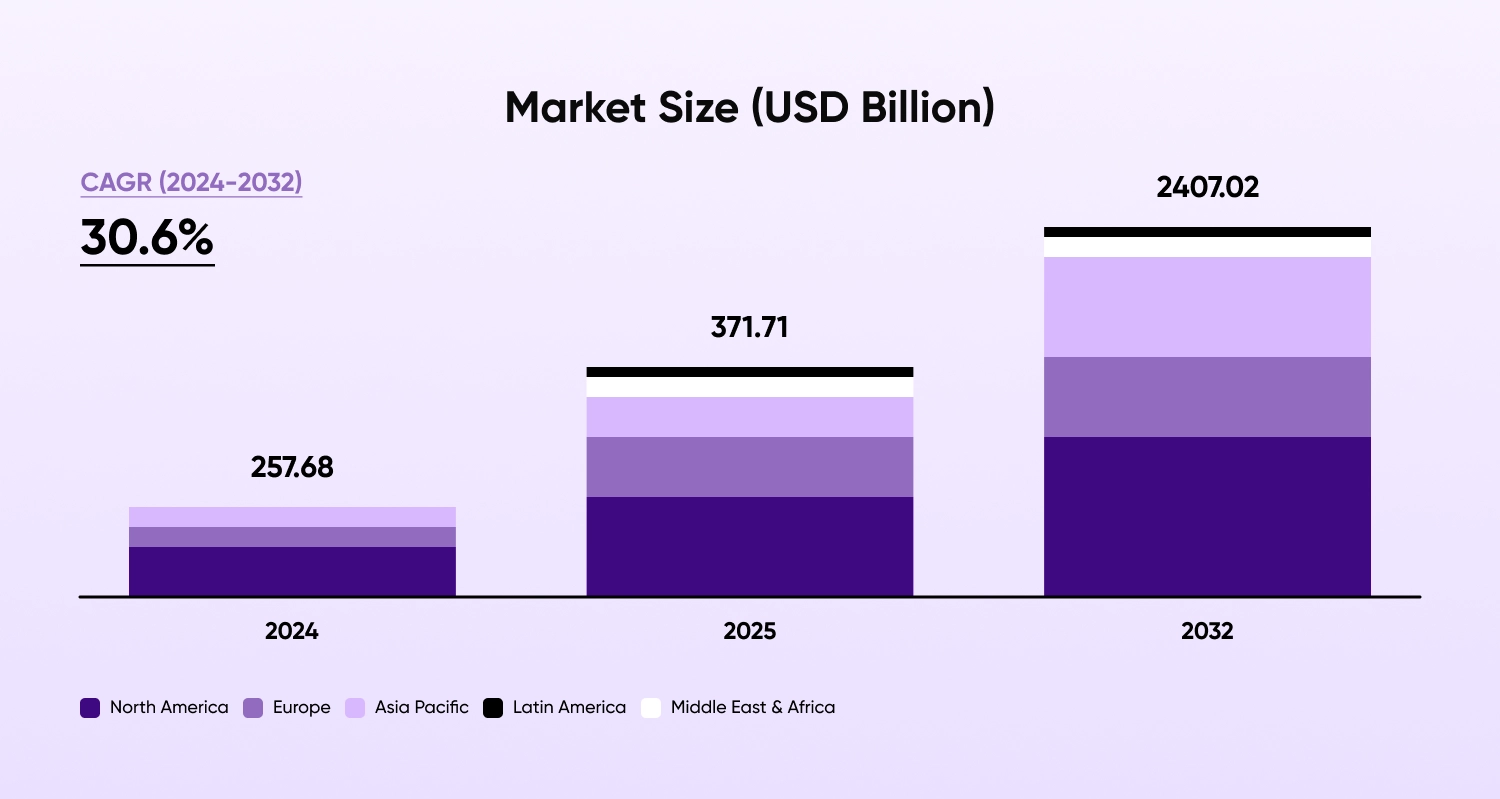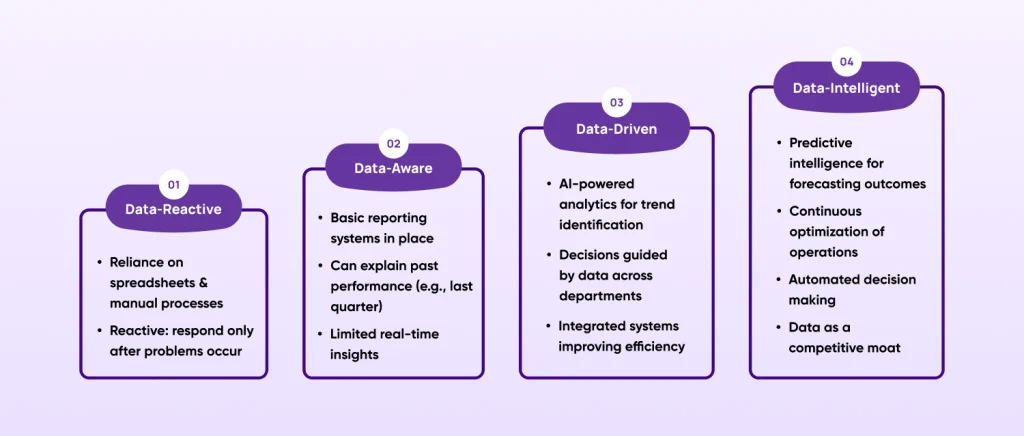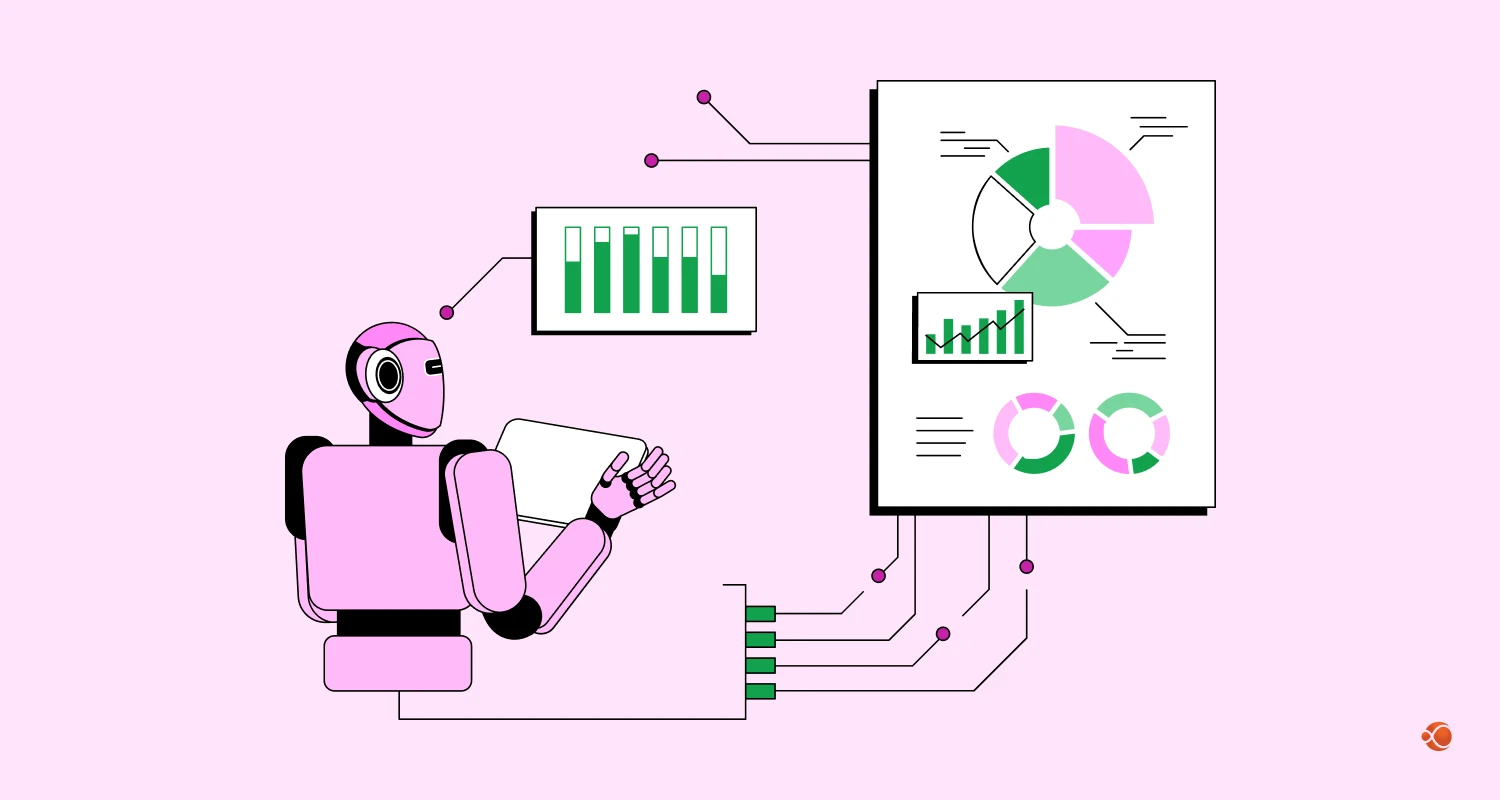Quick Summary: Data and AI are redefining business success. From personalization and fraud detection to supply chain optimization, companies using AI are pulling ahead. This blog reveals a clear roadmap to transform, innovate, and thrive before competitors leave you behind.
Business transformation isn’t just a buzzword anymore; it’s survival. Companies that master data and AI integration are pulling ahead while others struggle to keep up with the competition. We’re living through the most significant shift in how businesses operate since the internet boom.
Traditional business models that worked well for decades are crumbling. Decision-making based on quarterly reports simply doesn’t cut it. When your competitors can predict customer behavior, they can also optimize operations in real-time and automate complex processes. The AI market size will grow from approximately $372 billion in 2025 to about $2.4 trillion by 2032, showing a (CAGR) compound annual growth rate of around 30.6%.

The companies winning today share a common trait. They’ve transformed raw information into their most valuable asset. They use AI for data analysis to spot patterns humans miss and make decisions faster than ever before. By 2030, 170 million new job opportunities will be created globally, and 92 million jobs will be displaced.
This roadmap breaks down exactly how successful organizations build their transformation strategy. You’ll discover the technologies driving changes, implementation frameworks that work, and real examples of companies getting it right.
Understanding the Foundation: The Power of Data
Data as a Strategic Asset
The thing that separates winners from losers is that winners treat data like gold. They don’t see it as a byproduct of operations. They see it as the foundation of competitive advantage.
Intelligent organizations build entire strategies around AI data collection and analysis. They create systems that capture every customer interaction, market signal, and operational metric. This information becomes the fuel for smart decision-making.
The shift from reactive reporting to proactive intelligence happens when you stop asking what happened and start asking “what will happen.” Companies using advanced data analytics AI predict customer churn before it happens, identifying opportunities before competitors and optimizing inventory before shortages occur.
The Data Maturity Model

Most businesses exist in one of four stages. Each stage reflects how effectively they utilize the data to drive value and growth.
Stage 1 – Data-Reactive: In stage one, organizations still rely on spreadsheets and manual processes. They’re reactive, responding to problems after they occur.
Stage 2 – Data-Aware: Stage two companies have basic reporting systems. They can tell you what happened last quarter, but struggle with real-time insights.
Stage 3 – Data-Driven: In stage three, organizations utilize AI for data analytics to understand current trends. They make data-driven decisions and have integrated systems across departments.
Stage 4 – Data-Intelligent: In the last stage, companies achieve predictive intelligence. They use data science for business applications to forecast outcomes, continuously optimize operations, and automate decisions.
The goal is reaching stage four, where data becomes your competitive moat.
AI Data Integration: Connecting Intelligence Across the Enterprise
The real magic happens when raw data meets artificial intelligence. AI consulting services help companies understand this transformation, but the core concept is straightforward. AI finds patterns in data that humans simply cannot detect. Machine learning (ML) algorithms can process billions of data points simultaneously.
They identify correlations, predict outcomes, and recommend actions. Natural language processing turns unstructured text into insights. Computer vision extracts meaning from images and videos. AI data integration connects these technologies with existing business systems. Sales data flows into customer service platforms. Marketing analytics inform product development. Financial metrics guide strategic planning.
The human element remains important. AI provides intelligence, but humans provide wisdom. The most successful implementations combine artificial intelligence with human expertise to create solutions neither could achieve alone.
How Are Data and AI Technologies Reshaping Business Landscapes
| Technology Area | Description | Use Cases / Applications | Real-World Impact / Examples |
| Machine Learning & Advanced Analytics | Uses algorithms to learn from historical data and predict future outcomes. AI data management platforms automate data cleaning, organization, and preparation. |
|
|
| Natural Language Processing (NLP) & Data Mining | Extracts insights from unstructured text such as reviews, support tickets, and social media content. |
|
|
| Computer Vision & Real-Time Data Streams | Analyzes images and videos to interpret visual data. Real-time dashboards provide immediate insights. |
|
|
| Robotic Process Automation (RPA) & Intelligent Workflows | Automates repetitive tasks, enhanced with AI for quick decision-making and workflow automation. |
|
|
Machine Learning and Advanced Analytics
Machine learning is transforming how businesses understand their operation by using algorithms that learn from pre-existing data to predict future outcomes with accuracy. In practice, e-commerce platforms use it to recommend products tailored to customer behavior, while manufacturers apply it to predict equipment failures before they occur, reducing costly downtime.
AI data management platforms handle the complexity of processing massive datasets. They organize, clean and prepare information for analysis. This automation removes hours of manual work while improving accuracy. Real-world impact shows in the numbers. Netflix saves $1 billion annually through its recommendation algorithm. Amazon’s machine learning systems handle 35% of its revenue through product recommendations.
Natural Language Processing and Data Mining
Text contains incredible value that most organizations ignore. Support tickets, customer reviews, social media mentions, and internal communications hold insights about satisfaction, market opportunities, and product issues.
NLP systems extract this intelligence automatically. They analyze sentiment, flag important issues, and identify trends. Companies using these tools respond to customers’ concerns faster and identify product improvement earlier than competitors.
Major retailers process millions of customer reviews daily using NLP. They identify product defects, feature requests, and satisfaction patterns that help in creating marketing strategies and product development.
Computer Vision with Real-Time Data Streams
Visual data analysis opens entirely new possibilities. Retailers use computer vision to track customer behavior in stores. Manufacturers monitor production lines for quality issues. Security systems identify potential threats automatically.
AI data visualization tools present these insights in formats humans understand quickly. Dashboards update in real-time, showing key metrics and alerts.
Decision-makers access critical information instantly rather than waiting for reports. Tesla’s manufacturing facilities use computer vision to inspect every vehicle component. This system catches defects that human inspectors might miss while processing cars 10 times faster than manual inspection.
Robotic Process Automation and Intelligent Workflows
RPA eliminates repetitive tasks that consume employee time. But when combined with AI, automation becomes intelligent. Systems don’t just follow rules; they make decisions based on data patterns.
Generative AI integration services create new possibilities for workflow automation. Systems generate reports, create content, and respond to customer inquiries. This frees human workers to focus on more important strategic activities requiring judgment and creativity.
Financial services companies use intelligent RPA to process loan applications. The system reviews documents, verifies information, and makes preliminary approval decisions in minutes rather than days.
Key Areas Where Data and AI Are Driving Transformation
Customer Experience and Personalization
Modern customers expect customized experiences. They want recommendations that match their preferences, service that anticipates their needs, and content relevant to their interests.
AI for data analysis makes this possible at scale. Systems track customer behavior across various touchpoints, building detailed profiles that inform personalized interactions. Netflix recommends movies you’ll enjoy. Amazon suggests products you need. Spotify creates playlists matching your mood.
Advanced personalization goes beyond simple recommendations. AI systems now predict customer lifetime value, identify churn risk before it happens, and automatically adjust communication frequency and timing based on individual customers’ preferences.
Supply Chain Optimization
Supply chains include countless variables like transportation costs, demand fluctuations, supplier and external factors like weather or political events.
AI systems continuously optimize these networks. They predict demand more accurately than traditional forecasting methods and find potential disruptions before they impact operations. These AI systems recommend inventory adjustments that reduce costs while maintaining service levels.
Dynamic routing algorithms reduce the delivery times by 15-30% while cutting fuel costs. Predictive maintenance prevents supply chain disruptions by identifying potential equipment failures weeks in advance.
Fraud Detection and Risk Management
Financial fraud costs companies millions each year, and traditional rule-based systems often miss sophisticated schemes that evolve rapidly. AI data security systems overcome this challenge by learning from each transaction, identifying subtle anomalies, and adapting automatically to new attack methods. As a result, they not only reduce false positives but also catch more genuine threats in real time.
They reduce false positives while catching more actual threats. Banks using these systems prevent fraud losses while improving customer experience by reducing legitimate transaction blocks. Advanced behavioral analytics create unique “digital fingerprints” for every user, detecting account takeovers within seconds of occurrence.
Human Resources and Talent Management
AI is completely reshaping talent management by transforming how organizations attract, evaluate, and retain employees. Resume-screening algorithms process thousands of applications in minutes, identifying the best candidates while minimizing unconscious bias.
Employee sentiment analysis monitors engagement levels and predicts turnover risk before it becomes critical, while performance management systems deliver real-time coaching and highlight skill gaps that require targeted training. Workforce planning tools further optimize staffing levels by factoring in growth projections, predicted demand, and seasonal fluctuation, reducing hiring costs while making sure during peak periods.
Marketing and Sales Automation
Modern marketing increasingly depends on AI-powered automation and insights. Algorithms that map customer journeys track interactions across multiple channels and help marketers allocate budgets more effectively, attribute revenue to the right touchpoints. Predictive lead scoring identifies high-potential prospects so sales teams can prioritize their efforts, while dynamic content makes sure each visitor receives a personalized experience.
At the same time, AI enhances sales forecasting by analyzing market conditions, historical patterns, and individual rep performance, turning pipeline management into a predictive process that flags at-risk deals and recommends actions to close them successfully.
Financial Planning and Analysis
AI is transforming financial operations by automating routine tasks while adding advanced analytics, and anomaly detection highlights unusual spending that needs investigation. Cash flow forecasting incorporates hundreds of variables for more accurate liquidity planning, and budget variance analysis reveals trends that support better strategic decisions.
Automated reporting extracts information directly from raw data, while portfolio optimization tools use machine learning to balance risk and return. Even credit risk assessments are handled in real-time, enabling faster yet reliable loan approvals.
Product Development and Innovation
AI accelerates innovation cycles by simultaneously analyzing customer feedback, market trends, and competitive intelligence. Concept-testing algorithms predict product success rates before large investments are made, while design optimization tools automatically generate variations and test them against manufacturing constraints and user preferences.
Quality assurance systems identify potential defects early in development, preventing expensive rework later. Meanwhile, AI-driven feedback analysis extracts insights from reviews, support tickets, and social media and helps teams prioritize features and improvements that truly matter to users.
Benefits of Data and AI for Businesses

Efficiency and Cost Savings
Automation removes the need for manual processes that waste time and introduce errors. While AI adoption may seem complex, the efficiency gains make it worthwhile. For example, customer service teams can handle more inquiries with fewer agents, manufacturing lines deliver higher output with less waste, and marketing campaigns achieve better results even with smaller budgets.
The role of AI in digital transformation becomes clear when you calculate time savings. Processes that once took hours to complete are now completed in minutes. Analysis that requires days happens quickly.
Enhanced Decision-Making
Nowadays, data-driven decisions consistently outperform intuition-based choices. AI systems process insights faster and in a more effective manner than human teams, find patterns and variables that might otherwise be overlooked. Yet AI doesn’t replace human judgment; it improves it by providing clearer insights and more accurate predictions, allowing leaders to make final decisions with greater confidence.
Revenue Growth Opportunities
Forward-thinking companies use AI to identify new revenue streams by discovering underserved customer segments, optimizing pricing strategies, and developing products that meet emerging needs. Tools such as recommendation engines boost average order values, predictive analytics improve conversion rates, and dynamic pricing helps maximize revenue from every transaction
Risk Reduction and Compliance
Regulatory compliance becomes more complex each year, and manual processes not only consume resources but also increase the risk. AI systems help by monitoring compliance automatically and flagging issues before they escalate into violations. They also improve risk management by analyzing huge amounts of data for early warning indicators, allowing businesses to respond proactively instead of reacting to crises after they occur.
How Data and AI Revolutionize Business
Phase 1: Assessment and Strategy Development
Successful transformation starts with an honest assessment.
- Where does your business stand today?
- How do you currently make decisions?
- What are your biggest operational challenges?
Strategy development identifies specific opportunities for improvement. Focus on different areas where AI can deliver a measurable impact instantly. Customer service, inventory management, and marketing optimization often give the best starting points.
Setting clear ROI expectations prevents disappointment. AI projects should deliver specific, measurable benefits. Define the success metrics before implementation begins.
Phase 2: Infrastructure and Technology Setup
Artificial intelligence has solid technical foundations. Cloud computing platforms give the processing power and storage capacity needed for large-scale data analysis. Modern AI systems demand more computing resources than traditional business applications.
Data architecture design determines long-term success. Systems must collect, store, and process information effectively. Poor architecture creates issues that limit AI’s efficiency.
Platform selection affects everything that follows. Choose solutions that integrate with existing systems while providing room for expansion. Vendor partnerships matter because AI technology evolves quickly.
Phase 3: Implementation and Integration
Begin with a pilot program that tests concepts on a small scale. This method reduces risk while proving value. A successful pilot builds organizational confidence and support for larger initiatives. Scaling requires careful planning. Systems that work for hundreds and thousands of records might fail with millions. Performance testing makes sure solutions handle real-world data volumes.
Change management frequently determines implementation success. Employees need training on new processes and systems. Clear communication about benefits reduces resistance to change.
Phase 4: Optimization and Innovation
Transformation doesn’t stop after the initial implementation; it evolves through continuous improvement. AI systems refine themselves with more data, and businesses gain the confidence to explore advanced use cases that deliver even greater benefits, provided they have strong foundations in place. To stay ahead, companies must also adopt future-proofing strategies and build flexible architectures that adapt quickly as new technologies emerge.
Real-World Industry Transformation Powered by Data and AI
Retail: Personalization and Inventory Optimization
Retail giant Amazon has transformed the whole retail industry by using AI for customer recommendations and inventory management. Their systems predict demand at the product level, optimizing stock levels across millions of items. Personalized engines drive significant revenue increases. Customers see products they actually want to buy. Conversion rates improve while customer satisfaction increases. Generative AI in data science applications helps retailers create product descriptions, optimize pricing, and develop marketing content automatically.
Healthcare: Diagnostic AI and Patient Care Enhancement
Medical AI systems assist doctors in diagnosing conditions faster and more accurately. Radiology AI identifies cancers that the human eye might miss. Drug discovery platforms improve medication development.
Patient care gets improved when AI systems monitor vital signs continuously, alerting staff to changes that require attention. Electronic health records become valuable when AI extracts insights from clinical notes.
Manufacturing: Smart Factories and Predictive Maintenance
Smart factories use AI to improve quality control, optimize production schedules, and predict equipment failures. Sensors collect data from every machine, creating complete operational intelligence.
Predictive maintenance prevents expensive breakdowns by identifying problems before they cause failures. This approach reduces downtime while extending the life of equipment.
Financial Services: Risk Management and Fraud Detection
Banks use AI for algorithmic trading, credit scoring, and fraud detection. These systems process transactions in real-time, identifying patterns that indicate risk or opportunity.
Regulatory compliance benefits from AI systems that monitor transactions and communications for violations. Automated compliance reduces costs while improving effectiveness.
How to Build a Future-Proof Data and AI Strategy?
Emerging Technologies on the Horizon
Quantum computing solves optimization problems that current systems cannot handle. Edge computing brings AI processing closer to data sources, reducing latency and improving performance.
Synthetic data generation creates training datasets without security and privacy concerns. This technology allows AI development when real data is limited or sensitive.
Building Adaptive and Scalable Systems
Architecture matters more than any technology selection. Flexible systems adapt to new requirements and integrate emerging capabilities. Monolithic systems become obstacles to innovation.
API-first design allows integration with future technologies. Microservices architecture scales components separately. Cloud-native solutions take advantage of unlimited computing resources.
Creating a Culture of Continuous Innovation
Organizations need cultures that adopt experimentation and learning. Technology alone doesn’t cause transformation. Employees should feel included to suggest improvements and test new approaches. Innovation labs give safe spaces for experimenting with trending technologies. Cross-functional teams break down silos that prevent collaboration.
Establishing Strategic Partnerships and Ecosystem Development
Smart organizations collaborate with technology vendors, industry leaders, and research institutions. These relationships provide access to emerging capabilities before they become mainstream.
Ecosystem thinking makes value networks where partners share data and information. Platform businesses like Uber and Airbnb show how ecosystems generate more value than individual companies operating alone.
Preparing for Next-Generation AI and Autonomous Systems
Autonomous AI systems can make decisions without human intervention in a particular domain. Preparing for this requires establishing clear governance frameworks and ethical guidelines.
Self-improving AI systems will optimize their own performance continuously. Organizations need monitoring capabilities to make sure these systems remain aligned with business objectives.
Why Choose CMARIX for Your Data and AI Transformation Journey
Implementing a successful data and AI transformation requires more than just a clear understanding of technology. It demands an experienced team that can navigate complex technical challenges while delivering measurable business results.
CMARIX brings deep expertise in artificial intelligence and data analytics to help organizations execute their transformation strategies effectively.
Our team understands that each business has unique requirements, challenges, and objectives that require customized solutions. When you hire AI developers from CMARIX, you gain access to their professional developers who have successfully implemented AI solutions across various industries. Our developers don’t just write the code; they understand business context and deliver solutions that drive real value.
Final Words
The transformation from traditional business operations to data and AI-driven organizations is no longer optimal. It’s the difference between barely surviving and thriving in competitive markets. Companies that mastered this transformation gain a sustainable advantage. They make decisions faster, serve customers more effectively, and operate more than competitors, stuck with outdated approaches.
The roadmap is pretty clear: first, assess your current situation, build solid foundations, implement strategically and optimize continuously. Success requires investment, patience, and commitment, but the rewards justify the effort. AI software development services provide the technical expertise many organizations need to execute their transformation strategies successfully. Your competitors are already moving. The question isn’t whether to embrace this transformation but how quickly you can make it happen.
FAQs for Data and AI for Business Transformation
Why Must B2B Marketers Prioritize Data Quality and AI?
B2B marketers need accurate data to identify qualified leads and personalize campaigns effectively. Poor data quality leads to wasted budgets and missed opportunities, while AI amplifies both bad and good data quality.
How Are Businesses Using AI and Data Analytics to Gain a Competitive Advantage?
Companies use AI for predictive behavior analysis, automated decision-making, and real-time pricing optimization. They respond quickly to market changes and deliver customized experiences that competitors cannot match.
What Industries Benefit Most From Ai-Driven Data Strategies?
Healthcare, retail, and financial services see the highest returns from AI implementation. These industries handle large data volumes and have clear use cases for prediction and automation.
What Is the ROI of Adopting AI and Advanced Data Analytics?
Organizations usually see significant productivity improvements and cost reductions within the first year of proper implementation.
What Are the Future Trends in AI and Data-Driven Business Transformation?
Edge computing will bring AI processing closer to data sources, while quantum computing will solve complex optimization problems. Synthetic data generation and autonomous business processes represent the next frontier.







